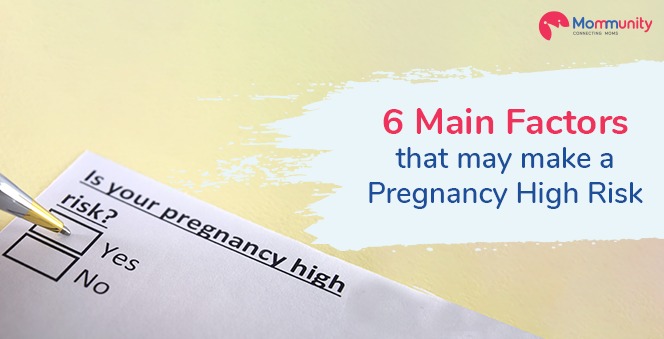When a woman finds out she is pregnant, she is filled with delight, excitement, and anticipation. However, if the pregnancy is considered high-risk, it can also be a period of anxiety, stress, and worry. A high-risk pregnancy means that extra care is required for a healthy and successful pregnancy and delivery. Women who start a normal pregnancy may develop issues that place them in the high-risk category, affecting roughly six to eight per cent of all pregnancies. However, many pregnancies—nearly half—are at risk and would benefit from specialised care from a maternal-fetal medicine subspecialist (high-risk pregnancy provider).
WHAT ARE THE CONSEQUENCES OF HAVING A HIGH-RISK PREGNANCY?
A high-risk pregnancy can also be caused by a medical problem that existed before conception. For some women, a medical issue arising during pregnancy could also increase the risk of the pregnancy.
Here are some specific factors leading to a high-risk pregnancy:
Maternal age is advanced. Mothers who are expecting babies above the age of 35 have a higher risk of pregnancy.
Personal preferences. Smoking, consuming alcohol, and using illegal drugs can all endanger a pregnancy.
Barriers to childbirth. High blood pressure, obesity, diabetes, epilepsy, thyroid disease, heart or blood abnormalities, poorly controlled asthma, and infections are some barriers to childbirth.
Complications of pregnancy Risks can arise from a variety of issues that occur during pregnancy. An abnormal placenta position, foetal growth below the 10th percentile for gestational age (foetal growth restriction), and rhesus (Rh) sensitization are just a few examples.
Pregnancy in multiples. Women having twins or higher-order multiples have more significant pregnancy risks.
A history of pregnancies If you’ve had a previous pregnancy-related hypertension illness, such as preeclampsia, your chances of getting this diagnosis during your subsequent pregnancy are higher. You’re more likely to have an early delivery in your subsequent pregnancy if you had a premature birth in your previous pregnancy or if you’ve had several premature deliveries. Discuss your entire obstetric history with your healthcare physician.
WHAT CAN BE DONE TO ENSURE A SAFE PREGNANCY?
Make a preconception appointment, for example. Before you become pregnant, talk to your doctor, they may advise you to begin taking a daily prenatal vitamin containing folic acid and maintaining a healthy weight. If you have a medical condition, your therapy may need to be changed to become pregnant. Your doctor may
Seek prenatal care regularly. Prenatal visits can help your doctor keep track of your health and that of your baby. A specialist in maternal-fetal medicine, genetics, paediatrics, or other fields may be referred to you.
Stay away from dangerous substances. Quit smoking if you’re a smoker. Alcohol and illicit drugs are also prohibited. Discuss any over-the-counter or prescription medications or supplements you’re taking with your doctor.
DO I NEED TO TAKE ANY SPECIAL TESTS?
Your doctor may advise you to do one of the following things, depending on the circumstances:
Ultrasound that is specialised or targeted. This sort of foetal ultrasound — an imaging technology that employs high-frequency sound waves to create images of a baby in the uterus — is used to look for a problem, such as abnormal development.
Cell-free DNA (cfDNA) testing during pregnancy. DNA from the mother and foetus is collected from a maternal blood sample during this process, and the foetal DNA is checked for an elevated risk of particular chromosome disorders.
Genetic testing is intrusive. Amniocentesis or a chorionic villus sample may be recommended by your doctor (CVS). A fluid sample that surrounds and protects a foetus during pregnancy (amniotic fluid) is removed from the uterus during amniocentesis. Amniocentesis, which is usually performed around week 15 of pregnancy, can detect some genetic problems and significant brain or spinal cord abnormalities (neural tube defects). A sample of cells from the placenta is extracted during CVS. CVS is a test usually done between weeks 10 and 12 of pregnancy to detect specific genetic abnormalities.
Cervical length can be measured using ultrasound. At prenatal appointments, your healthcare provider may use an ultrasound to assess the length of your cervix to see if you’re at risk of premature labour.
Tests in the laboratory Urine will be tested for urinary tract infections, and you will be screened for infectious disorders like HIV and syphilis.
A biophysical profile is created. This prenatal ultrasound is performed to check on a baby’s health during pregnancy. It could just be an ultrasound to assess foetal well-being or include fetal heart rate monitoring, depending on the ultrasound results (nonstress test).
Amniocentesis and chorionic villus sampling are two prenatal diagnostic techniques that could create a minor risk of pregnancy loss. You and your partner must decide whether or not to go for these tests.
IS THERE ANYTHING ELSE I SHOULD KNOW ABOUT HIGH-RISK PREGNANCY?
Consult your doctor about how to manage any medical concerns you may have while pregnant, as well as how your health may affect labour and delivery.
Contact your healthcare provider, in case you develop the following:
- Severe headaches
- Pain or cramping in the lower abdomen
- Reduced foetal activity
- Pain or burning with urination
- Changes in vision, including blurred vision
- Unexpected or severe swelling in the face, hands, or fingers
- Fever or chills
- Vomiting or persistent nausea
- Dizziness
- Thoughts of harming yourself or your baby
There may be ups and downs with a high-risk pregnancy. As you make your way to prom, try to keep a pleasant attitude.



